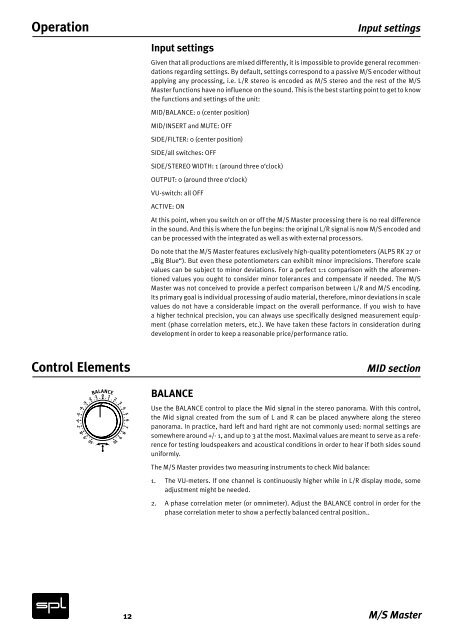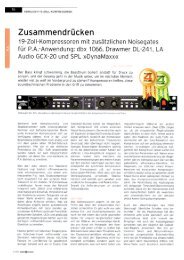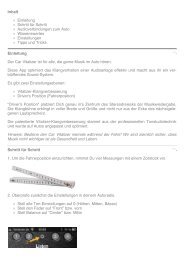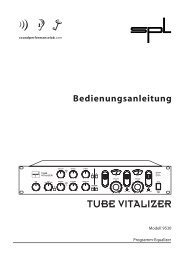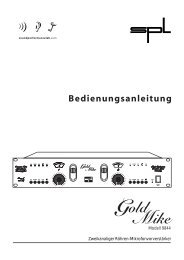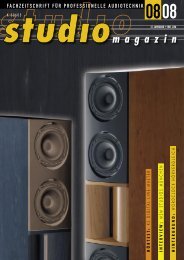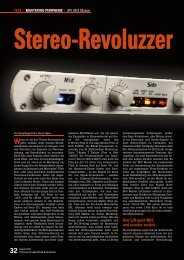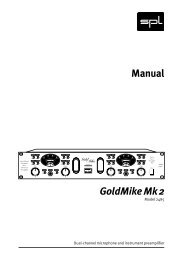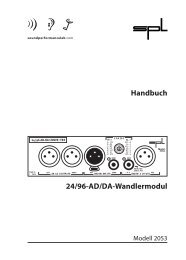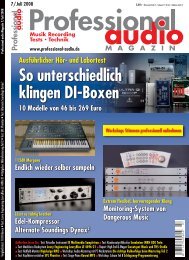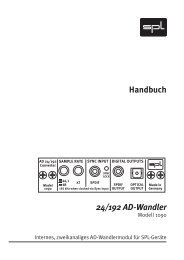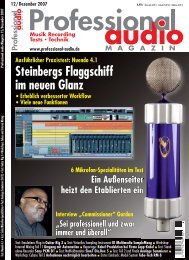Create successful ePaper yourself
Turn your PDF publications into a flip-book with our unique Google optimized e-Paper software.
Operation<br />
Control Elements<br />
BALANCE<br />
-10 -9 -8 -7 -6 -5 -4 -3 -2 -1 0 1 2 3 4 5 6 7 8 9 10<br />
Input settings<br />
Input settings<br />
Given that all productions are mixed differently, it is impossible to provide general recommendations<br />
regarding settings. By default, settings correspond to a passive M/S encoder without<br />
applying any processing, i.e. L/R stereo is encoded as M/S stereo and the rest of the M/S<br />
<strong>Master</strong> functions have no influence on the sound. This is the best starting point to get to know<br />
the functions and settings of the unit:<br />
MID/BALANCE: 0 (center position)<br />
MID/INSERT and MUTE: OFF<br />
SIDE/FILTER: 0 (center position)<br />
SIDE/all switches: OFF<br />
SIDE/STEREO WIDTH: 1 (around three o‘clock)<br />
OUTPUT: 0 (around three o‘clock)<br />
VU-switch: all OFF<br />
ACTIVE: ON<br />
At this point, when you switch on or off the M/S <strong>Master</strong> processing there is no real difference<br />
in the sound. And this is where the fun begins: the original L/R signal is now M/S encoded and<br />
can be processed with the integrated as well as with external processors.<br />
Do note that the M/S <strong>Master</strong> features exclusively high-quality potentiometers (ALPS RK 27 or<br />
„Big Blue“). But even these potentiometers can exhibit minor imprecisions. Therefore scale<br />
values can be subject to minor deviations. For a perfect 1:1 comparison with the aforementioned<br />
values you ought to consider minor tolerances and compensate if needed. The M/S<br />
<strong>Master</strong> was not conceived to provide a perfect comparison between L/R and M/S encoding.<br />
Its primary goal is individual processing of audio material, therefore, minor deviations in scale<br />
values do not have a considerable impact on the overall performance. If you wish to have<br />
a higher technical precision, you can always use specifically designed measurement equipment<br />
(phase correlation meters, etc.). We have taken these factors in consideration during<br />
development in order to keep a reasonable price/performance ratio.<br />
BALANCE<br />
MID section<br />
Use the BALANCE control to place the Mid signal in the stereo panorama. With this control,<br />
the Mid signal created from the sum of L and R can be placed anywhere along the stereo<br />
panorama. In practice, hard left and hard right are not commonly used: normal settings are<br />
somewhere around +/- 1, and up to 3 at the most. Maximal values are meant to serve as a reference<br />
for testing loudspeakers and acoustical conditions in order to hear if both sides sound<br />
uniformly.<br />
The M/S <strong>Master</strong> provides two measuring instruments to check Mid balance:<br />
1. The VU-meters. If one channel is continuously higher while in L/R display mode, some<br />
adjustment might be needed.<br />
2. A phase correlation meter (or omnimeter). Adjust the BALANCE control in order for the<br />
phase correlation meter to show a perfectly balanced central position..<br />
12 M/S <strong>Master</strong>


